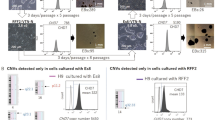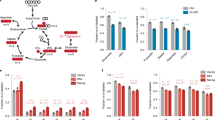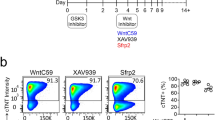Abstract
We describe a method to help overcome restrictions on the differentiation propensities of human pluripotent stem cells. Culturing pluripotent stem cells in dimethylsulfoxide (DMSO) activates the retinoblastoma protein, increases the proportion of cells in the early G1 phase of the cell cycle and, in more than 25 embryonic and induced pluripotent stem cell lines, improves directed differentiation into multiple lineages. DMSO treatment also improves differentiation into terminal cell types in several cell lines.
This is a preview of subscription content, access via your institution
Access options
Subscribe to this journal
Receive 12 print issues and online access
$259.00 per year
only $21.58 per issue
Buy this article
- Purchase on Springer Link
- Instant access to full article PDF
Prices may be subject to local taxes which are calculated during checkout



Similar content being viewed by others
References
Osafune, K. et al. Nat. Biotechnol. 26, 313–315 (2008).
Bock, C. et al. Cell 144, 439–452 (2011).
Smith, A.G. Annu. Rev. Cell Dev. Biol. 17, 435–462 (2001).
Orford, K.W. & Scadden, D.T. Nat. Rev. Genet. 9, 115–128 (2008).
Conklin, J.F. & Sage, J. J. Cell Biochem. 108, 1023–1030 (2009).
Ben-David, U. & Benvenisty, N. Nat. Rev. Cancer 11, 268–277 (2011).
Hartwell, L.H. & Weinert, T.A. Science 246, 629–634 (1989).
Murray, A.W. & Kirschner, M.W. Nature 339, 275–280 (1989).
Pardee, A.B. Science 246, 603–608 (1989).
Weinberg, R.A. Cell 81, 323–330 (1995).
Chen, S. et al. Nat. Chem. Biol. 5, 258–265 (2009).
Sawai, M., Takase, K., Teraoka, H. & Tsukada, K. Exp. Cell Res. 187, 4–10 (1990).
Teraoka, H., Mikoshiba, M., Takase, K., Yamamoto, K. & Tsukada, K. Exp. Cell Res. 222, 218–224 (1996).
Ponzio, G. et al. Oncogene 17, 1159–1166 (1998).
Fiore, M. & Degrassi, F. Exp. Cell Res. 251, 102–110 (1999).
Yu, Z.W. & Quinn, P.J. Biosci. Rep. 14, 259–281 (1994).
Pal, R., Mamidi, M., Das, A. & Bhonde, R. Arch. Toxicol. 86, 651–661 (2012).
D'Amour, K.A. et al. Nat. Biotechnol. 24, 1392–1401 (2006).
Kroon, E. et al. Nat. Biotechnol. 26, 443–452 (2008).
Borowiak, M. & Melton, D.A. Curr. Opin. Cell Biol. 21, 727–732 (2009).
Cowan, C.A. et al. N. Engl. J. Med. 350, 1353–1356 (2004).
Takahashi, K. et al. Cell 131, 861–872 (2007).
Chen, P.L., Scully, P., Shew, J.Y., Wang, J.Y. & Lee, W.H. Cell 58, 1193–1198 (1989).
Sosa-García, B. et al. PLoS ONE 5, e13954 (2010).
Ruiz, S. et al. Curr. Biol. 21, 45–52 (2011).
Sela, Y., Molotski, N., Golan, S., Itskovitz-Eldor, J. & Soen, Y. Stem Cells 30, 1097–1108 (2012).
Jacks, T. et al. Nature 359, 295–300 (1992).
Slack, R.S. et al. J. Cell Biol. 129, 779–788 (1995).
Nguyen, D.X., Baglia, L.A., Huang, S.-M., Baker, C.M. & McCance, D.J. EMBO J. 23, 1609–1618 (2004).
Watanabe, K. et al. Nat. Biotechnol. 25, 681–686 (2007).
Boulting, G.L. et al. Nat. Biotechnol. 29, 279–286 (2011).
Maehr, R. et al. Proc. Natl. Acad. Sci. USA 106, 15768–15773 (2009).
Chambers, S.M. et al. Nat. Biotechnol. 27, 275–280 (2009).
Zhang, P. et al. Blood 111, 1933–1941 (2008).
Lian, X. et al. Proc. Natl. Acad. Sci. USA 109, E1848–E1857 (2012).
Rezania, A. et al. Diabetes 60, 239–247 (2011).
Acknowledgements
We thank E. Scadden for her excellent technical support; R. Maehr, P. Makhijani and J. Millman of Harvard University for providing many of the hiPSC lines; K. Lam for assistance with the Cellomics high-content screening system; and A. Meissner, K. Eggan, D. Cohen, R. Maehr, J. Rivera-Feliciano, B. Blum, J. Sneddon and Q. Peterson for their comments on the manuscript. This work was supported by the Harvard Stem Cell Institute, the Howard Hughes Medical Institute, the Leona M. and Harry B. Helmsley Charitable Trust, NovoNordisk and the US National Institutes of Health (1R24DK092758 and 1U01HL10040804).
Author information
Authors and Affiliations
Contributions
S.C. and D.A.M. conceived and designed the research, analyzed the data and wrote the manuscript. S.C., F.W.P., C.H., A.K. and A.R. performed the experiments.
Corresponding author
Ethics declarations
Competing interests
A.R. is an employee of BetaLogics, a division of Janssen Research & Development that is developing commercial products based upon pancreatic differentiation of human embryonic stem cells.
Supplementary information
Supplementary Text and Figures
Supplementary Figures 1–12, Supplementary Tables 1 and 2 and Supplementary Note (PDF 2913 kb)
DMSO treatment of hESCs generates functional cardiomyocytes (video 1 of 4)
DMSO treatment of the HUES6 cell line enhances the potential for cardiomyocyte differentiation and induces functionality by promoting contractile properties. (MOV 2020 kb)
DMSO treatment of hESCs generates functional cardiomyocytes (video 2 of 4)
DMSO treatment of the HUES6 cell line enhances the potential for cardiomyocyte differentiation and induces functionality by promoting contractile properties. (MOV 13785 kb)
DMSO treatment of hESCs generates functional cardiomyocytes (video 3 of 4)
DMSO treatment of the HUES6 cell line enhances the potential for cardiomyocyte differentiation and induces functionality by promoting contractile properties. (MOV 6905 kb)
DMSO treatment of hESCs generates functional cardiomyocytes (video 4 of 4)
DMSO treatment of the HUES6 cell line enhances the potential for cardiomyocyte differentiation and induces functionality by promoting contractile properties. (MOV 5436 kb)
Rights and permissions
About this article
Cite this article
Chetty, S., Pagliuca, F., Honore, C. et al. A simple tool to improve pluripotent stem cell differentiation. Nat Methods 10, 553–556 (2013). https://doi.org/10.1038/nmeth.2442
Received:
Accepted:
Published:
Issue Date:
DOI: https://doi.org/10.1038/nmeth.2442
This article is cited by
-
Rational design and synthesis of a novel BODIPY-based probe for selective imaging of tau tangles in human iPSC-derived cortical neurons
Scientific Reports (2022)
-
Engineering brain assembloids to interrogate human neural circuits
Nature Protocols (2022)
-
Sustained intrinsic WNT and BMP4 activation impairs hESC differentiation to definitive endoderm and drives the cells towards extra-embryonic mesoderm
Scientific Reports (2021)
-
Modeling different types of diabetes using human pluripotent stem cells
Cellular and Molecular Life Sciences (2021)
-
Cryopreservation Engineering Strategies for Mass Production of Adipose-Derived Stem Cells
Biotechnology and Bioprocess Engineering (2021)



